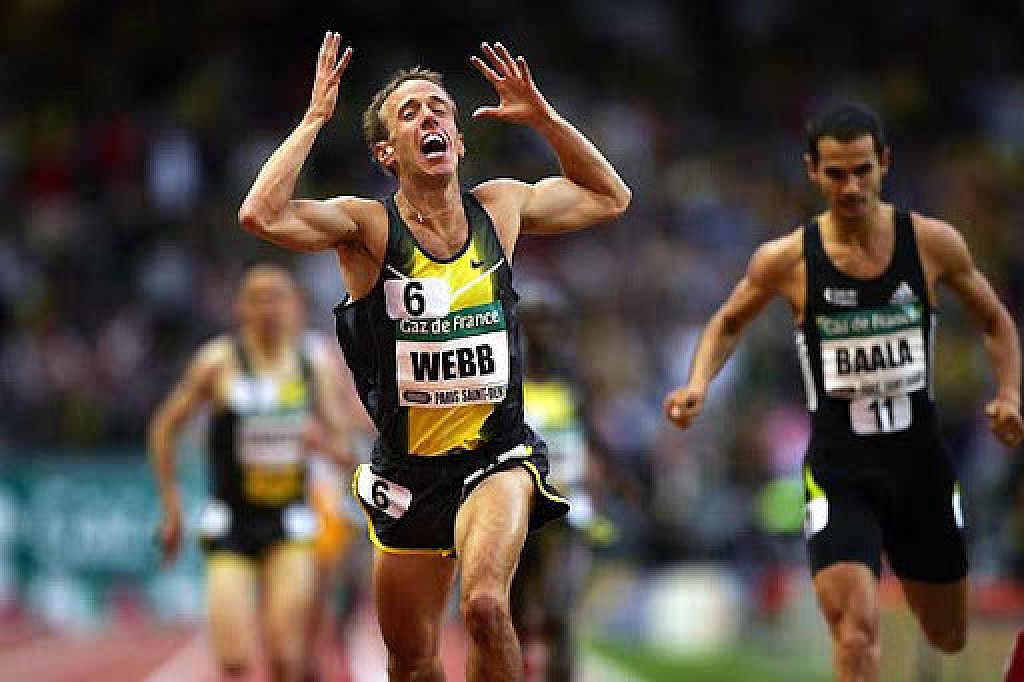Running News Daily
Running News Daily is edited by Bob Anderson in Mountain View, California USA and team in Thika Kenya, La Piedad Mexico, Bend Oregon, Chandler Arizona and Monforte da Beira Portugal. Send your news items to bob@mybestruns.com Advertising opportunities available. Over one million readers and growing. Train the Kenyan Way at KATA Running Retreat Kenya. (Kenyan Athletics Training Academy) in Thika Kenya. Opening in june 2024 KATA Running retreat Portugal. Learn more about Bob Anderson, MBR publisher and KATA director/owner, take a look at A Long Run the movie covering Bob's 50 race challenge.
Index to Daily Posts · Sign Up For Updates · Run The World Feed
Articles tagged #Alan Webb
Today's Running News
Confirmed! When serial track rivals Josh Kerr and Jakob Ingebrigtsen will face off
The date when a showdown between 1500m Olympic champion Jakob Ingebrigtsen and 2023 1500m world champion Josh Kerr has been confirmed.
Serial track rivals Josh Kerr and Jakob Ingebrigtsen have both been confirmed as headliners for the Bowerman Mile at the Prefontaine Classic, the fourth leg of the Diamond League Meeting series happening in Eugene, USA on May 25.
The duo has been known to attack each other with the two-time World 5000m champion from Norway also attacking the Scot most of the time.
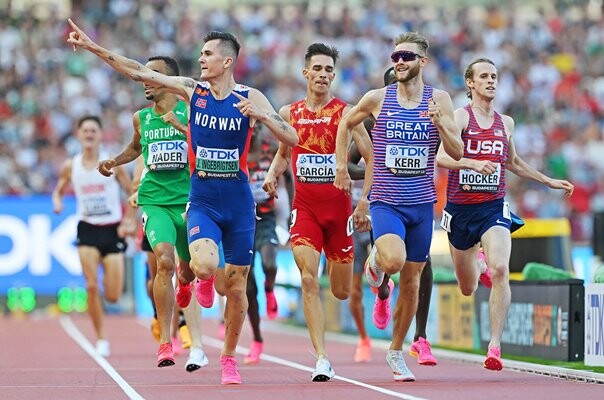
The Norwegian, from time to time has been on record, trash-talking his rivals including Kerr and he once referred to him as the guy next door.
In his recent interview Speaking to the UK Times, Ingebrigtsen noted that he believes his competitors are irrelevant and very inconsistent when it comes to the sport.
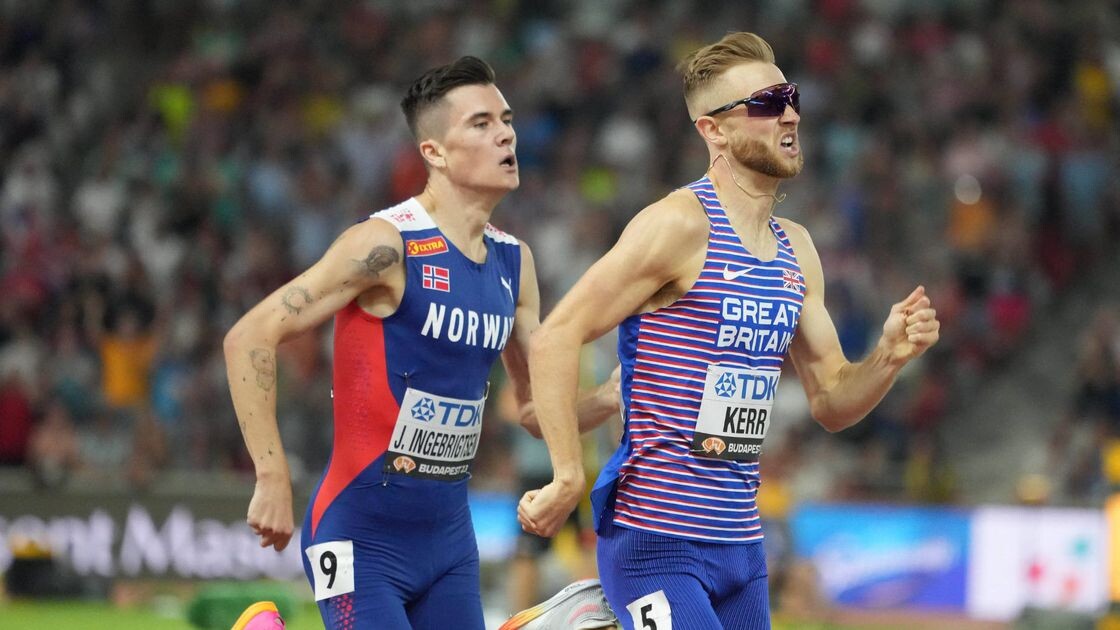
“I’m going to say my competitors are irrelevant in the way I see them all the same. One of the main issues is they are very inconsistent and that means my rivals are always changing.
“From 2017 I have had ten to 12 different rivals. It’s easier for them to have a rival in me but not as easy for me to have a rival in them,” Ingebrigtsen said.
After the Scot broke the two-mile indoor world record, the World 1500m silver medallist also made fun of him and noted that he would have beaten him blindfolded.
“I would have beaten him in that race, blindfolded… But it’s good that people run better than they have done before,” Ingebrigtsen said.
The duo now clashes at the Prefontaine Classic and Kerr will be debuting at the event. U.S. indoor and outdoor mile record holder Yared Nuguse will also be in the mix.
In last year’s race, Ingebrigtsen battled to the finish line with Nuguse with the Norwegian star winning in 3:43.73. Nuguse took nearly three full seconds off Alan Webb’s American record with a 3:43.97.
(03/12/2024) Views: 182 ⚡AMPby Abigael Wuafula
Yared Nuguse Shatters American Mile Record At Prefontaine Classic
Yared Nuguse shattered the American record in the Bowerman Mile, finishing second to Norway's Jakob Ingebrigtsen in 3:43.97 at the Prefontaine Classic.EUGENE -- Yared Nuguse shattered the American record in the Bowerman Mile, finishing second to Norway's Jakob Ingebrigtsen in 3:43.97 at the Diamond League Prefontaine Classic at Hayward Field.
Nuguse lowered the previous American mark of 3:46.91 set by Alan Webb in Belgium in 2007. His time now ranks fourth on the all-time world list.

“I feel like a 3:44, 45 felt reasonable, but 43 is the same second as the world record which is absolutely insane that we were able to do that today, but still (have) a great race,” Nuguse said.
Ingebrigtsen won the race in the third-fastest time in history 3:43.73, establishing new Diamond League, Pre Classic and European records while pulling the entire field to extraordinary performances. Everyone in the race clocked sub-3:54 and established either a new season best or personal best. There were also there national record and world U20 mark established.“I think he pushes all of us to be better, and that’s really huge," Nuguse said of Ingebrigtsen. "To have someone like this at the time same time that I’ve come to my peak is just really big, to make me catch things that I didn’t think were possible, like running 3:43.”
As expected, from the early going, this shaped up to be a two-man race between Ingebrigtsen and Nuguse. In the pre-meet press conference Nuguse stated that he wanted the American record. Ingebrigtsen playful told Nuguse to hang with him as long as he could and he just might get it.
And he was right.
Pacer extraordinaire Eric Sowinski kept the two runners on world-record pace, taking them through 800m in 1:51.67. When he stepped off slightly before 1200m, Ingebrigtsen had covered the next quarter in 56.06 with Nuguse right on his heels. The duo hit the bell in 2:47 and the race against the clock and each other was very much on.
“He does a very good race," Ingebrigtsen said of Nuguse. "Obviously he’s in a good enough shape to run what he does, but at the same time today I wanted to race where I could challenge myself to really set out at a decent pace, somewhat conservative, and then I go as hard as I could the last two laps to try to run as fast as I could. So it was very good.”As the two hit the back straight, it was apparent from the green LED pacing lights on the rail that they had fallen about two strides behind world-record pace but the intrigue was far from over.
They remained tight rounding the next to last curve when Ingebrigtsen turned the screw with 150 to go and began to open slight daylight. Nuguse covered the move and pulled right back onto the heels of the leader.
Coming down the stretch, Nuguse grimaced as he tried to keep up with Ingebrigtsen, moving wide to lane two to try and get passed but he was unable to close the gap.
“This is gonna be my last chance for a while to beat him, I might as well just pour my whole heart into it," Nuguse said of his mindset late in the race. "It was the perfect race because I just felt very unbothered the entire time, so it was all just really gritting it out and seeing who could run faster. But you know, definitely tough competitor but still felt really good about it.”
Nuguse credited the passionate crowd at Hayward Field -- there were 12,634 ticketed spectators in attendance -- with providing him with the home-cooking spark he needed late in the race.
"“Definitely that third lap, I feel like having that crowd just going nuts was really huge," he said. "I could just feel they’re all cheering for me for once, when I feel like in Europe they’re mostly cheering for him. It was still just a really amazing crowd, I always love hearing a big roar, especially here in Eugene.”While Nuguse can kick back into the offseason and start recharging for the Olympic year -- he said, his plans are to “just have a ton of fun tonight, not think about running for a month” -- Ingebrigtsen has one more race to go in his season, and on a tight turnaround. The 5000m world champion is favored in tomorrow's men's 3000m.
"Obviously I was here to run the mile," Ingebrigtsen said of his focus. "I’m jumping in the 3k because I got the opportunity. But now it’s all about getting back home to the hotel, eat, sleep, try to prepare as good as I can and we’ll see tomorrow.”
After the meet ends, is Ingebrigtsen's year done?
"Not quite," he said. "Hopefully getting married next weekend, so I think I have to prepare for that as well.”
(09/17/2023) Views: 474 ⚡AMPby Joe Battaglia Flotrack
Prefontaine Classic
The Pre Classic, part of the Diamond League series of international meets featuring Olympic-level athletes, is scheduled to be held at the new Hayward Field in Eugene. The Prefontaine Classicis the longest-running outdoor invitational track & field meet in America and is part of the elite Wanda Diamond League of meets held worldwide annually. The Pre Classic’s results score has...
more...Five high school boys have combined to break the four-minute barrier seven times in 2022 and no one has enjoyed it more than Jim Ryun
Jim Ryun was the first high school boy to break the four-minute barrier in the mile as a Kansas 17-year-old in 1964 and went on to a legendary track and field career that included three Olympic appearances in the 1,500m, a silver medal in the 1968 Mexico City Olympics, and numerous American and world records.
Ryun’s name always surfaces when a high schooler dips under 4 minutes in the mile. And in 2022, his name has been coming up a lot.
Ryun’s career was also in the spotlight earlier this month when he was one of 30 former college track and field athletes inducted into the inaugural class of the USTFCCCA’s Athlete Hall of Fame in conjunction with the NCAA Championships in Eugene, Ore.

The original 4-minute high school barrier breaker celebrates the resurgence of American high school distance running and says for too long runners were held back in fear of what would happen if they ran under 4 minutes for the mile.
“I think they realize it’s not a barrier that can’t be broken, it’s more of a matter that if you break it,” Ryun said, “will you go on from there, which you can because we’re seeing more and more of them that are doing that.
“It’s not the barrier that it once was, should never have been there. For a long time, there were three of us. Myself, Marty Liquori and Tim Danielson. We were the only (sub) 4-minute milers from high school for years and I think it was the result of people being afraid of that, and coaches saying if you run too fast, too soon you’ll never make it very far.”
Growing up, Ryun often wondered if he would ever be successful in an athletic endeavor. He tried basketball and football and was cut from his church baseball team. At a high school assembly, Bob Timmons, the school’s track and field and cross country coach, encouraged students to run on his cross country team in the fall.
Ryun had never run more than one lap around a track before joining the cross country team, but in one season at Wichita East High School, he went from the last runner on the third-string team to a sixth-place finish at the Kansas state meet.
“Running was so new to me, I didn’t know who the heroes were,” Ryun recalled. “In fact, my first thought was I wanted to be a baseball, football, basketball player. Running, what’s that? So, it took a while. The first book Coach Timmons gave to me was about Emil Zatopek, the great Olympian, so I read that, and it began helping me understand about the sport.”

Ryun said Timmons was convinced he could be the first high school runner to break 4 minutes in the mile. That came true on June 5, 1964, when Ryun ran 3 minutes, 59.0 seconds to finish eighth at the Compton Invitational in Los Angeles.
“The goal originally was my coach’s because I was the kid that got cut from the church baseball team, didn’t have great talent and when I started running, I was looking for direction,” Ryun said. "And he began basically teaching me about goals, how to reach goals, and gave me workouts to get there. The night that I ran 4 minutes, 3:59.0, I didn’t sleep that night (before) because I realized that it was his goal.
“But my thought was, what happens if I take ownership, ownership being there’s certain things you as an athlete know you could do like maybe a little extra weightlifting, better eating. It was a transformational moment, because I mean when you finish eighth in a race and become the first kid to run under 4 minutes, that has to change your life – and it did.”
Ryun’s running career took off from there. He made the 1964 U.S. Olympic team in the 1,500m that went to Tokyo and was the last U.S. high school men’s track and field athlete to make the U.S. Olympic team until teenager Erriyon Knighton qualified for the 2020 Tokyo Olympics in the 200m and finished fourth there.
As a high school senior, Ryun broke 4 minutes four more times. His time of 3:58.3 at the 1965 Kansas state meet was the first time 4 minutes was broken in a high school-only meet. On June 4, 1965, Ryun returned to the Compton Relays, the site of his first sub-4-minute mile and ran 3:56.8. A little over three weeks later, he ran 3:55.3 at the U.S. AAU Championships in San Diego and beat New Zealand’s Peter Snell, the 1964 Olympic champion in the 800m and 1,500m.
Ryun, who would stay close to home and attend Kansas University after graduating from high school in 1965, roomed with a former Jayhawks great, Billy Mills, during U.S. training camps leading up to the 1964 Olympics. In Tokyo, Mills stunned the world by becoming the only U.S. athlete to ever win the Olympic 10,000m.
In 1966, Tim Danielson became the second American high schooler to break 4 minutes when he ran 3:59.4. A year later, Marty Liquori ran 3:59.8 to become the third high schooler under 4 minutes.
Ryun and Liquori had illustrious careers after high school, particularly Ryun. At age 19 in 1966, Ryun set two world records, first in the 800m (1:44.9), and then the mile (3:51.3). He was the NCAA indoor mile champion for Kansas in 1967, 1968 and 1969, and the 1967 outdoor NCAA mile champion. In 1967, he set a 1,500m world record of 3:33.1 that stood for seven years.
That same year, he lowered his mile world record to 3:51.1., a mark that stood for almost eight years. Ryun was the last American man to hold the mile world record. He still holds American junior records for the mile (3:51.3) and 2-mile (8:25.1), and his 800m American junior record of 1:44.9 stood for exactly 50 years.
In 2003, ESPN.com ranked Ryun as the greatest U.S. high school athlete of the 20th century, ahead of Tiger Woods, LeBron James, Lew Alcindor (now Kareem Abdul-Jabbar), Wilt Chamberlain, Marion Jones, and others.
After Ryun, Danielson, and Liquori, the 4-minute mile wasn’t broken by a prep athlete again for more than 32 years until Alan Webb ran 3:59.86 at the New Balance Games in New York on Jan. 20, 2001. Sensing something special in Webb, the promoters of the Prefontaine Classic in Eugene, Ore., invited him to run in the Bowerman Mile, the signature event of the meet that has since become a Diamond League event, on May 27, 2001.
Morocco’s Hicham El Guerrouj, still the world record-holder in the 1,500m and mile, won the event in 3:49.92, followed by Kevin Sullivan of Canada and Bernard Lagat, then of Kenya, who later ran for the U.S. They helped pull Webb to a fifth-place finish in 3:53.43, breaking Ryun’s 36-year-old high school record.
“I thought he would. I just didn’t know how much he would break it by," Ryun said. “It was one of those moments in time where he had run well, but he needed somebody to help him get over that finish line, just as I did running under 4 minutes for the first time. You need someone to help set the pace. You can relax a little bit, and he was able to take advantage of that.
“So, there was no real surprise to me. The biggest surprise was that there weren’t more high school boys running under 4 minutes.”
It would be another 10 years before a high schooler would break 4 minutes in the mile. In 2015, Matthew Maton and Grant Fisher, now the U.S. record-holder in the men’s 10,000m, both ran 3:59.38 about one month apart. In 2016, two runners broke 4 minutes, including Drew Hunter, who did it twice in a 15-day span in February indoors, both times in New York.
The 4-minute barrier was broken by high schoolers once in 2017 and again in 2020 during the height of the COVID-19 pandemic. In 2021, Hobbs Kessler ran the fastest high school mile since Webb when he ran 3:57.66 indoors. Kessler later that year broke Ryun’s 1,500m American junior record of 3:36.1 that stood for almost 55 years.
The lack of American high school runners breaking 4 minutes in the mile for decades might be a big reason why U.S. men haven’t enjoyed much Olympic or international success until recently. When Matthew Centrowitz won the men’s 1,500m at the 2016 Rio de Janeiro Olympics, he was the first American man to do so since 1908. At the same Olympics, Clayton Murphy won the bronze medal in the 800m, the first American man to medal in the event since 1992.
And when the World Athletics Championships are hosted on U.S. soil for the first time next month in Eugene, Ore., the defending 800m men’s champion is American Donavan Brazier.
“If you look back in history, you’d see there was a dominance maybe by a country for a time like Great Britain had all those great runners. America at one time was dominant in that area as well,” Ryun said. “So, I think it’s a matter of floating from place to place, and I think it comes down to motivation. How motivated are you?
“Over time you start realizing that motivation has to come down to you be willing to get up, run in all kinds of weather, race all over the world and let those talents be developed that God’s given you. So, it takes time. I think America can come back with dominance, but it also comes down to how motivated you are. I see the Kenyans as very motivated, and America can be just as motivated as you see with these new young runners that are developing quickly.”
That has proven to be the case this season. Seventeen high school runners have broken the 4-minute barrier, and 2022 has been the banner season for it so far with five runners breaking the mark seven times.
“I think a lot of coaches are seeing, too, that kids are just developing a lot faster doesn’t mean you’re going to burn out,” Ryun said. “It means you’ve got great opportunities. Will you decide to keep it going and, in my case, will you take ownership? The coach can only take you so far, but then you have to establish ownership.”
The owner of the fastest prep mile this year is Colin Sahlman, who ran 3:58.81 indoors in February, and, like Webb, was invited to the Bowerman Mile at the Prefontaine Classic. In a field that included 2020 Tokyo Olympic 1,500m gold medalist Jackob Ingebrigtsen, defending World Athletics Championships 1,500m gold medalist Timothy Cheruiyot, and defending 1,500m NCAA outdoor champion Cole Hocker, Sahlman finished 13th in 3:56.24. Of the 14 men who finished the race, seven set personal bests and seven set season bests, including Ingebrigtsen, whose time of 3:49.76 is the fastest in the world this year.
Sahlman’s time moved him to third on the all-time prep list behind Webb and Ryun. Sahlman, who is headed to Northern Arizona University for college, was part of a high school powerhouse at Newbury Park High in Southern California. In 2021, Newbury Park became the first high school team to have four runners break 4:10 for the mile in the same season.
“That mindset has really evolved and developed over these last three to four years,” Sahlman said in a March article in the Los Angeles Times. “It’s just like it’s transformed into something that we never thought was possible. Now we think anything’s possible.”
Gary Martin has also broken 4 minutes twice this year, running 3:57.98 on May 14 and 3:57.89 on June 2 in the Festival of Miles in St. Louis. At the Festival of Miles, Connor Burns ran 3:58.83 to become the first high school junior since Ryun to break 4 minutes. It was also the first time two prep runners broke 4 minutes in the same race.
Those two performances gave the Festival of Miles four prep runners who have broken 4 minutes. That’s where Fisher did in 2015, a feat repeated by Reed Brown a year later.
And one day after Martin and Burns broke 4 minutes, Rheinhardt Harrison ran 3:59.33 in Florida on June 3. On June 15, Simeon Birnbaum added to the list of sub-4 minute runners when he became the second high school junior this season to break the mark with a time of 3:59.51.
Will this high school running resurgence lead to greater U.S. success against international competition and major global championships? Only time will tell.
(06/20/2022) Views: 1,165 ⚡AMPby Ashley Conklin (World Athletics)
Gary Martin goes 3:57.98 (third fastest high schooler ever behind only Alan Webb and Jim Ryun) to win today's Philadelphia Catholic League Championsips
Another day, another milestone for Gary Martin. And this one was a biggie.
The Archbishop Wood High School senior ran a sub-four minute mile Saturday at the Catholic League championships at Cardinal O'Hara.

After just missing the milestone at the Penn Relays, he ran Saturday's race at 3:57.98. It was the 20th time a high school runner accomplished the feat, and his time was the sixth fastest ever for a high school student. Overall, he was the 14th runner to break the four-minute mark and it was the fastest time in state history. It was the first in the state to break the 4-minute mark.

Martin has been breaking records all year, beginning in cross country, and continuing during the indoor and outdoor seasons.
Last week Martin broke the state record in the 3,200-meter run, posting a 8:41.57 mark to break Robert DiDonato’s record of 8:44.98 set at this meet last year.
The University of Virginia signee will have more chances to smash records at the state meet.
The Archbishop Wood senior has been on a quest to become the first Pennsylvania high school athlete ever to run a sub-four-minute mile.
Running with a purpose and leading from the start, Martin made history with a sizzling time of 3:57.98.
Martin raised his hands in triumph as he crossed the finish line. His time was the fastest in the county by nearly 10 seconds.
“I’ve had a couple of really good workouts this week and I felt I was in shape to do it,” Martin said. “Looking at the weather, I thought it was going to be a good day and it’s one of my last opportunities to really just run an all-out mile before we get into postseason stuff. I just wanted to go for it, see how I was feeling through two laps. I felt good. I was right on so I kept going.”
Martin found the warm conditions with a light rain to his liking as he took the lead in the first 50 meters and kept his foot on the gas. He ran the first quarter in 59.67 seconds, the second in 58.79, the third in 59.87 and the final in 59.62 to obliterate the meet record of 4:14.08 set by O’Hara’s Steve Hallinan and take his place in history.
“For me, I like to run even splits,” Martin said. “I like to settle into a pace, find a pace I need to run and then hold on throughout, which is what I did today. That’s kind of the goal going in. You just have to stay mentally tough.”
Martin wasn’t done for the day. He also won the 800 in a meet-record time of 1:51.29, to break the mark of 1:52.95 set by O’Hara’s Pat Nash in 2000. And Martin anchored Wood’s 4 x 400-meter relay team to a silver medal by two-tenths of a second to take home the outstanding boys track performer of the meet away.
(05/14/2022) Views: 1,328 ⚡AMPAlan Webb Leaves Arkansas Little Rock to Take On a new Coaching Gig
Alan Webb, the American record holder in the mile, posted on Instagram that he is leaving Arkansas Little Rock (D1 school) to coach at the Catholic High School for Boys which is at a high school in Little Rock. "I am excited to announce that I am going to be joining the @catholic_high_school_for_boys cross country and track coaching staff along side the awesome @jendista I have had so many good memories that I will take with me from my time with @Littlerocktfxc and am grateful for everything I learned from @coachbehnke and all the incredible @Littlerocktfxc athletes. Really excited for Dustin Mettler, a rising star in coaching to be taking over my position. He is going to help take the Little Trojans to the next level. I am also going to pursue a Master of Arts in Catechetics and Evangelization from @franciscanuniversity “And Mary said: My soul proclaims the greatness of the Lord; my spirit rejoices in God my savior.” Luke 1:46-47

American Record Holder and former United States Olympian Alan Webb is set to Run Grandma's Marathon
Once, and perhaps still, a household name in short-distance running, former United States Olympian Alan Webb will make his 26.2-mile debut later this month at the 2021 Grandma’s Marathon.
Webb, who still owns the American record in the mile with a time of 3:46.91, competed in the 2004 Athens Olympics in the 1500-meters and also won three gold medals at the USA Outdoor Track and Field Championships.

Now an assistant cross country and track and field coach at the University of Arkansas Little Rock, he says the timing is right to try the longer distance.
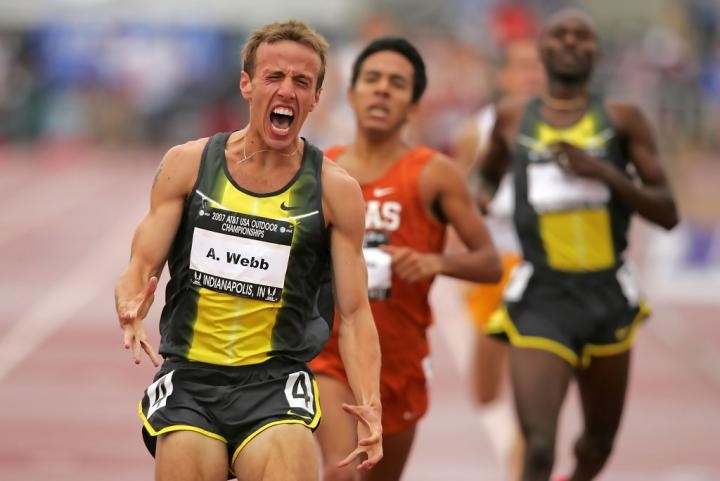
“I’ve always heard good things about Duluth and about Grandma’s Marathon,” Webb said. “I’m not so much running now to be competitive, I’m running because I love to do it and because of what the sport has meant to me my whole life. The timing of Grandma’s works well for my coaching schedule, and I’m excited to come to Minnesota and to run on this beautiful course.”
Webb made his half marathon debut on May 29 at the Great American River Run in Memphis, Tenn., finishing in fourth place with a time of 1:13:14.
Webb and his wife, Julia, are currently living in Little Rock, Ark. and have three children.
The 45th annual Grandma’s Marathon weekend will be held June 17-19, 2021.
(06/08/2021) Views: 1,172 ⚡AMPby Running USA
Grandmas Marathon
Grandma's Marathon began in 1977 when a group of local runners planned a scenic road race from Two Harbors to Duluth, Minnesota. There were just 150 participants that year, but organizers knew they had discovered something special. The marathon received its name from the Duluth-based group of famous Grandma's restaurants, its first major sponsor. The level of sponsorship with the...
more...Introducing the Country’s Fastest High Schooler
Hobbs Kessler is taking the running world by storm
Last February, Hobbs Kessler, a 17-year-old senior from Michigan who has committed to run for the University of Northern Arizona next fall, set a new high school record for the indoor mile. His time of 3:57.66 made him only the twelfth American high schooler to break the four-minute barrier since Jim Ryun first did it in 1964. The feat was all the more notable considering that Kessler’s mile PB coming into the race was a comparatively modest 4:08.4, which he ran last summer. As Track and Field News noted, Kessler’s record had come “seemingly out of nowhere.”

One explanation for Kessler’s sudden arrival into the upper ranks of American middle-distance running is that the pandemic has caused a number of rising stars to train in relative obscurity, with far fewer official meets to document the gradual progression of their talent. (Apparently, Kessler’s 4:08 mile last year was set in a time trial.) No wonder, then, that after his record-breaking run in February, the narrative around Kessler quickly morphed from Who is this guy? to What else is he capable of?
At last weekend’s Portland Track Festival, we found out. In the men’s 1,500-meters, Kessler, now 18, ran 3:34.36 to break Alan Webb’s 20-year-old high school record in the “metric mile” by almost four seconds—an eternity in such a short race. What’s more, Kessler’s time was also quicker than the men’s collegiate 1,500-meter record (3:34.68) and faster than the current Olympic standard (3:35.00). The guy few people had heard of six months ago was suddenly on the shortlist for the greatest U.S. high school runner, ever.

Until recently, track and field wasn’t even Kessler’s primary focus. In 2019, he represented the United States at the IFSC Climbing World Youth Championships. I caught up with Kessler to chat about the miraculous evolution of his young running career, choosing track over climbing, and his plans for the future.
OUTSIDE: Last summer, you cracked 4:10 in the mile for the first time. Less than a year later, you’ve run a 1,500 that converts to a 3:51. Are you shocked by how quickly you’ve progressed in such a short time? Can you still savor the moment?
KESSLER: In early 2020, I just wanted to run 4:13, indoors, in the mile. And then it kind of snowballed from there. I’ve gotten used to shifting my mindset on how I view myself as a runner. As I keep upping it, I always think, “OK, this is the last time,” but it hasn’t been so far. So, it’s been a little crazy in that regard, but I’m really enjoying it. I feel like I’ve been able to adapt my mindset really quickly—a lot faster than my folks. I think they’re still stuck six months back, which is pretty funny.
By “shift in mindset,” I’m guessing you mean a shift in expectations that you have for yourself. Are you worried that you might not be able to live up to your own standards, considering how quickly you’ve progressed?
I guess it can be a double-edged sword. In the winter, before I broke four for the first time, the 60-second-per-lap pace was everything, so that’s what we did all our workouts at. Now that I’m more fit, 57 is the new 60. But it’s all about not viewing it as fast. Because if I thought of 4:10 as fast, then I’d probably be running 4:10. So, you can control some of it with your mind. As far as not living up to expectations, I know that at some point I’m going to take a hit and not be running as well. But this season, I’ve been taking everything in stride and good things have been happening. I’ve never worried that I wasn’t going to run well.
There’s a theory that the bizarre circumstances of the pandemic might have helped some athletes nurture their talent by clearing their racing schedule. Is there any sense in which the events of last year changed your approach to training and racing?
As far as training goes, I would say the pandemic allowed me to just take a block from March 2020 to August to just get stronger. When the season got shut down, my dad switched me over to doing tempos on Tuesdays and hills on Fridays. But I was doing a lot of really fast strides because I wanted to develop my speed. Trying to work on my form. I’m a fairly fresh runner and haven’t been at it that long, so my running form is still very malleable. I didn’t have a race to worry about, so I just ran two big workouts a week and a big long run. I think people are realizing that racing less and training more can yield faster times. I’ve probably only gone all-out five times this year—but when I do decide to go all-out, I put a lot of emphasis on not wasting the opportunity.
I know that you are coached by your father, but also by Ron Warhurst—a legend in the coaching world, who is credited with “inventing” one of the sport’s most famous workouts. Do you have a favorite session that you like to do—perhaps something from Warhurst’s catalog of torture?
Both Ron and my dad have a lot of input in my training, but I’m more on Ron’s program now. I would say that my favorite workout of Ron’s has to be “Michigan,” because it’s his signature thing and you hit pretty much every pace and it can also be adjusted to wherever you’re at.
You’ve qualified for the Olympic Trials in the 1,500 as a high schooler. That’s nuts. But you’re also in a good spot in which there’s no pressure and where, presumably, you can just go and enjoy the experience. How do you plan to approach the Trials and do you have any other running goals for the summer?
After I broke four minutes in the mile, getting to the Trials was really the big goal. So I’m very excited about that race. Originally, I was just viewing it as a great experience where I could learn a lot so that, in three years, I might be in a position to compete for a spot on the team. But now that I’m one of the few people with the Olympic standard, my mindset has changed a bit. My thinking is that, if I’m there, I might as well have a run at the team. It’s a win-win because if I make the Olympic team that would be awesome, but if I don’t, I’m only 18 and will have a lot more attempts at it. I feel like I’m in a very cool spot where there’s no pressure, but I might as well give it a go.
You have an impressive climbing background, but it seems like you’ve decided to prioritize running for now. Was that decision based primarily on the fact that running is where you have the most talent, or was it something else?
I’m definitely prioritizing running, but I wouldn’t say it’s a conscious decision. That’s just the sport that I’ve drifted more towards in the past year or two and it’s what I’m more excited about. It’s not that I decided that I could be more successful at it, so much as that I’ve drifted towards it throughout high school.
Do you feel like the two sports complement each other in some way?
I think climbing really helps running, but running doesn’t really help climbing.
How so?
Well, the big carryover from both—and this does go either way—is that the mental stuff is the same. Race nerves in running and redpoint jitters in climbing. So there it’s the same stuff. In competitive climbing, I had to develop skills to deal with it, which translated directly to my running. But I think running destroys my coordination a little bit for climbing, so it’s hard to do both at the same time. I tried to be really good at both at the same time, but it just wasn’t possible because they started fighting each other a little bit. So I decided to let go of trying to be really good at climbing and to just do it because I enjoy the act of it.
You’ve now run a time that is faster than the NCAA 1,500-meter record. Unsurprisingly, this has fueled speculation that you might decide to go pro and skip college-level racing altogether. Do you think that early success can obscure the fact that running talent still needs to develop gradually?
When I was talking to colleges that was one of the biggest criteria I had. I wanted to make sure they developed me and weren’t just trying to get as much out of me while I was in school. So I’ve kind of had that view. Running aside, if I were to go pro, it would have to create a situation that would be worth missing out on the experience of being in college and being on a team. And I really want that experience. I’m not ready to be done being on a cross-country team. So going pro would have to outweigh that by a significant amount. Everything seems really immediate and important right now, but I have confidence it will even out. Whatever decision I make, I have confidence in the people who have been guiding me so far.
(06/04/2021) Views: 799 ⚡AMPby Outside Online
Hobbs Kessler Breaks Alan Webb’s Legendary High School 1500m Record
Runs 3:34.36 to Get Under Olympic Qualifying Standard
In one of the most incredible runs ever by an American high schooler, 18-year-old Hobbs Kessler ran a 3:34.36 1,500m at the Portland Track Festival tonight to obliterate the US high school record. The previous record, 3:38.26, was set by Alan Webb as a 1500 split en route to his legendary 3:53.43 high school mile record at the 2001 Prefontaine Classic.
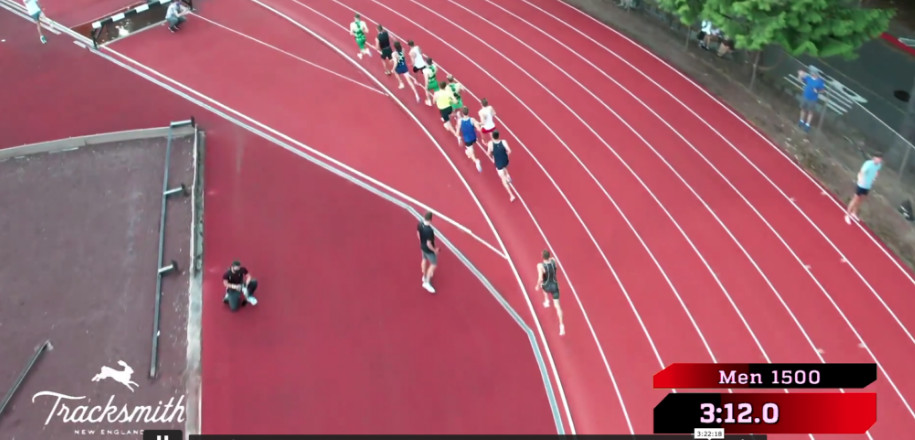
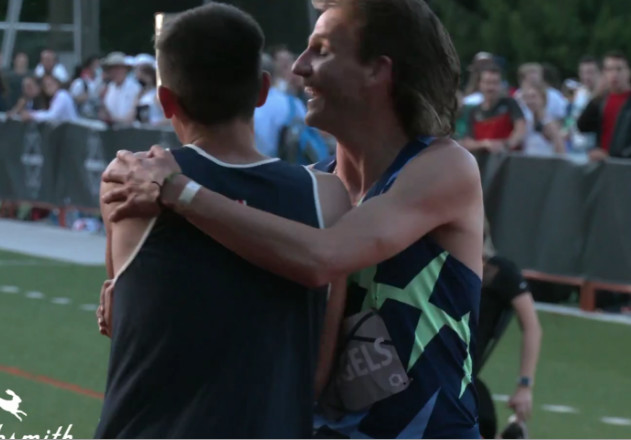
Webb’s 3:53.43 has gone unchallenged for two decades, but according to World Athletics’ scoring tables, Kessler’s 1500 tonight was the superior performance; converting to 3:51.34 for the mile (Webb’s 3:53.43 mile converts to 3:36.30 for 1500). Kessler’s time is also faster than Jim Ryun‘s US U20 1,500 record of 3:36.1 which had stood since 1966.
Kessler, who was last in the lead pack of ten with 200m to go, moved up well the final 100 meters, and threw up his hands just before the finish line as he saw the clock and finished 5th in a race won by reigning US champ Craig Engels in a personal best of 3:33.64. Engels, the 2019 US indoor/outdoor champion and a World Championship finalist, entered tonight with a pb of 3:34.04 — barely faster than what Kessler ran.
Kessler, a senior at Community High School in Ann Arbor, Mich., was already a high school record holder after running 3:57.66 in February to take down the indoor mile record. Now he is, quite simply, one of the best milers in the United States, regardless of age. His time was the third-best by an American in 2021 — only the winner Engels and fourth-placer Henry Wynne (3:34.08) have run faster this year.
How incredible was Kessler’s run? He didn’t just break the US high school record by almost four seconds; he also ran faster than the collegiate record of 3:34.68 set by Notre Dame’s Yared Nuguse two weeks ago. He also hit the Olympic standard of 3:35.00 — one of just seven Americans to have done so during the qualification period.
Kessler’s run was so much faster than any other high schooler has run for 1500 that it is hard to even make comparisons. Webb’s 3:53.43 at Prefontaine, which celebrated its 20th anniversary on Thursday, is the obvious one. Just like Webb, Kessler finished 5th in a field of pros, and just like Webb, Kessler was mowing them down over the final 100 meters.
As impressive as Kessler’s run was tonight, it was not the greatest ever performance by an American U20 athlete. That remains Jim Ryun’s 3:51.3 mile in July 1966 — a world record at the time that would stand for eight years. Ryun was just 19 years old at the time of that race, which came after his freshman year of college.
Kessler is a high school senior. His sometimes training partner, Nick Willis, an Olympic 1500m silver and bronze medallist, was in this race and tried to put it in perspective on the broadcast afterwards, “I became a spectator to the greatest performance ever by a high school miler,” said Willis, noting he himself went out at the pace prescribed for the rabbits for 800, yet was in last place. “It’s like Jim Ryun reincarnated again…He’s such a rookie in terms of running…. He’s so raw.”
(05/30/2021) Views: 1,343 ⚡AMPby Let’s Run
Keira D’Amato Is Trying to Break the American 10-Mile Record on Monday. It Could Cost Her Thousands of Dollars.
Since 2011, Keira D’Amato has been part of the race committee for the Credit Union Cherry Blossom Ten Mile Run, the famous Washington, D.C. road race held along the banks of the Potomac River. She’s held a few different roles over the years; recently she’s been responsible for coordinating speakers for clinics at the race expo. This year, Molly Huddle was one of the scheduled speakers, and D’Amato told her she believed Huddle could break the women’s-only American record of 52:12, set by Janet Bawcom at Cherry Blossom in 2014 (coincidentally, D’Amato held the finish line tape for that race). After telling Huddle about the record, D’Amato realized something: I can run that fast too.
Over the following six months, as D’Amato has risen from obscurity to one of the best distance runners in the United States, that statement has become blindingly obvious. After running a personal best 2:34:24 to finish 15th at the Olympic Marathon Trials in February, the 36-year-old has spent the summer and fall demolishing her pbs, from a 15:04 time trial 5,000 on the track in June to a 32:33 10,000 at the MVMNT Race Series in July to a 68:57 to win the Michigan Pro Half Marathon on October 28.


On Monday, D’Amato will try to back up her claim from the spring: she’s going for Bawcom’s record at the Up Dawg Ten Miler, where she’ll face a five-woman professional field that includes Olympian Molly Seidel. And that leads into one of the oddest statistics of a very odd year.
If D’Amato had broken the record at Cherry Blossom in April (which cancelled its 2020 edition due to COVID-19), she would have earned a $10,000 bonus.
If D’Amato breaks the record on Monday — or even if she doesn’t — she could end up out around $8,000.
That’s because D’Amato is covering most of the costs of the Up Dawg Ten Miler, which will take place in an undisclosed location in the DC area. Even though D’Amato is staging a race for five athletes rather than Cherry Blossom’s typical 17,000, several key expenses remain: getting the course USATF-certified and measured, securing park permits and road closures. It can add up quickly.
And then there is drug testing. USATF rules state drug testing is only required to ratify American records in events for which World Athletics recognizes an official world record. Since 10 miles is a “world best” distance, that means drug testing isn’t required to ratify an American record at the Up Dawg Ten Miler — but D’Amato is leaning toward including it anyway to avoid all doubts. However, based on the quote she received from USADA, it would run her an extra $3,000-$3,500. She hasn’t made a final decision yet.
There is an online store selling race merchandise to help offset the cost of the event. And around 20 members of the CUCB organizing committee have also chipped in a total of $2,000 — and, more importantly, their time — so that D’Amato can chase the record.
“If there was a way to measure intensity per person, this race would be much more intense [than the Cherry Blossom Ten Mile Run],” says CUCB event director Phil Stewart. “We’re not dealing with getting 17,000 people entered in the race and moving them around or ordering as many porta potties or things like that, but this is a group of special individuals. I’ve spent a lot of time being consumed by making sure that we have all of the conditions set for the record to be accepted if the record is broken. If Keira or anybody breaks the record here, the worst nightmare would be that there was some little USATF rule that I didn’t know about that was required for an American record to be set.”
Stewart knows that feeling all too well; last year, Stanley Kebenei thought he had broken Greg Meyer‘s American 10-mile record at Cherry Blossom, only for it to be revealed that a set of cones had been improperly placed, making the course 240 feet short (CUCB still paid Kebenei the $10,000 bonus).
With no mass race entries to fund the Up Dawg Ten Miler, CUCB will lose money on the event. But it’s worth it to Stewart to support D’Amato, whose meteoric rise he has followed first-hand — Stewart was among a group of CUCB committee members who traveled to Atlanta to support her in the Trials in February.
“One of the things that has been fun about [this event] is that in a time when there’s so much downbeat news, I think a lot of people have gotten excited about working on something that’s upbeat,” Stewart says.
And D’Amato? Well, in keeping with her carefree, laid back demeanor, she’s trying not to think about the cost and electing to focus on the positives. Five fast women (Susanna Sullivan, Bethany Sachtleben, and Emily Durgin round out the field) are gathering on Monday at 8 a.m. to race 10 miles. There will be a free live stream, with commentary, on the CUCB Facebook page. This should be fun, right? No. This will be fun.
“For me, it’s not about the money at all,” D’Amato says. “Right now when everyone’s starving for motivation and opportunity, I felt like this would be a service to the running community. And it fell in line really perfectly with my training too.”
Keira D’Amato’s return to competitive running began with a joke. Which, if you know anything about D’Amato, could not be more fitting.
D’Amato loves all things humor. The name of Monday’s race, Up Dawg, was her idea — a nod to a joke from The Office. When D’Amato joined Strava a few years ago, she began using jokes or puns to title her runs. Sample entry: November 16. My cousin, a magician, decided to incorporate the use of trapdoors in his shows. But I think it’s just a stage he’s going through. She used to rely on her children’s popsicle sticks for material or by asking her Amazon Alexa, “Tell me a joke.” As she amassed Strava followers (she’s over 2,600 now), she began receiving suggestions from fans — which delights her to no end.
“You have no idea how awesome it is that when people hear a funny joke, they think, Oh, I need to send this to Keira,” she says.
D’Amato’s impishness was on display during Christmas 2016, when she decided to gift her husband, Anthony, an entry to the 2017 Shamrock Marathon, held in March in Virginia Beach.
“Who gives someone a gift of a marathon entry?” D’Amato says. “Because that means you have to start training a lot. It’s kind of a backhanded compliment gift, I guess. But then I felt a little bad, so I signed up too.”
D’Amato was no stranger to running. A four-time All-American at American University under coach Matt Centrowitz, she finished 6th at the 2005 NCAA XC champs as a senior, ahead of future stars Amy Cragg, Molly Huddle, and Jenny Simpson. She remains friendly with the Centrowitz family, and is even in a fantasy football league with Olympic 1500 champ Matthew Centrowitz — let’s just say both D’Amato and Centro are better runners than fantasy football managers.
“I think at one point, I was in second-to-last and he was dead last,” D’Amato says. “But I also think Centro does a whole bunch of them, so maybe in his other leagues he’s doing better. But it was either the first or second week, I played him, and I crushed him.”
After graduating in 2006, D’Amato (then known as Keira Carlstrom) spent a few years running for DC Elite, a post-collegiate group coached by Scott Raczko — better known as the coach of Alan Webb. By 2008, she had lowered her 1500 personal best to 4:22, but was in constant pain, beset by a series of stress fractures and ankle pain. Her issues were the result of a condition known as a tarsal coalition — an abnormal bridging of bones in the foot — but the surgery to correct it was not covered by her insurance.
So D’Amato “retired” and got a job at mortgage giant Freddie Mac. Even after undergoing surgery to correct her condition in 2009 (her new job had better insurance), D’Amato ran sparingly for the next seven years. In her first run back after giving birth to her daughter, Quin, in August 2016 (she also has a six-year-old son, Tommy), D’Amato couldn’t make it through a three-minute run without walking. Yet she steadily built up ahead of Shamrock, and despite hail, sleet, and brutal winds on race day, D’Amato blew past her pre-race goal of 3:25.
“I couldn’t run slow enough to do that pace,” says D’Amato, who ran 3:14.
D’Amato felt there was a lot left in the tank, and took her next marathon, in Richmond in November, more seriously. After running 2:47 there — just two minutes off the Olympic Trials standard — she knew it was time to return to serious training. She reunited with Raczko, and steadily dropped her times while balancing running with her career as a realtor. When she ran a pb of 2:34 to finish 15th at the Trials at age 35, it looked like the culmination of a remarkable three-year journey.
In reality, D’Amato was just getting started.
Since the Trials, D’Amato has run personal bests over almost every distance. Her 15:04 5,000 doesn’t officially count because it came in a time trial rather than a race, but it’s faster than the Olympic standard of 15:10 and would have ranked her 6th in the US during the 2020 outdoor season.
Her most impressive performance came in last month’s Michigan Pro Half Marathon, where she clocked 68:57, 47 seconds ahead of runner-up Emma Bates, a 2:25 marathoner who finished 7th at the Olympic Trials. That made D’Amato the second-fastest American half marathoner on the year, behind Sara Hall, and 10th on the US all-time list. She is now in very elite company.
(11/22/2020) Views: 1,139 ⚡AMPby LetsRun
Beers, Bomb Suits and Blue Jeans: The Weirdest Mile-Run Records Known to Man-13 baffling ways humans have covered 5,280 feet
The running and drinking communities have long shared an unlikely Venn diagram. In the 1930s, some athletes would bring beer along for lengthy workouts, believing that its hearty grains might propel them to longer distances. For decades, at the end of the Berlin Marathon, runners who’ve made the podium are given medals and enormous boots of Erdinger. And these days, running clubs like Toronto’s RUNTOBEER start and finish at breweries around the city. Hell, there’s even a craft brewery in Chico, California, called Sufferfest that’s operated by lifelong runners and makes light, low-calorie ales designed for the highly active beer drinker.
Still, there is no greater (nor less subtle) collision of these two disciplines than the infamous Beer Mile, a concept that is arguably more popular than any internationally sanctioned event in the entire sport of track and field. It’s an irresistible blend — the familiarity of elementary-school gym class with the low-class hijinks of college — and it’s at the forefront of an unofficial, utterly unasked-for movement in both the amateur and professional running circles: run four laps hard, but make it weird.
In the last five months, runners have set two new, preposterously specific mile-run records: one while handcuffed, and one while wearing a pair of blue jeans. It would be tempting to laugh these efforts off, if only they weren’t so fast. (The jeans miler rumbled in at an unholy 4:06.) And really, at the end of the day, it’s fun to embrace these races, which wed the appeal of an old, oft-forgotten sport with stunts and gimmicks that thrive on social media.
Which is exactly what we’ve done. Below, find the 13 weirdest mile-run records known to man — including the fastest miles ever run in a bomb suit, with a dog and under the influence of chocolate milk.
Fastest Beer Mile
Corey Bellemore, 4:33
Bellemore actually ran a 4:24 about a year after his 4:33 mark, but got disqualified for leaving a combined 4.5 ounces of beer in his “empties.” Those judges are serious. As is his running ability; he’s an Adidas-sponsored athlete with a personal best of 3:57 to his name. Which is a crucial theme in the world of wacky mile records: always eager for a challenge, the pros inevitably hijack the bonkers creations of layman runners. Just six years ago, for instance, the running world had celebrated its first sub-five beer mile. Check out the full catalogue of all-time bests here, including stats on the favored beers. (Budweiser is currently in the lead, though Bellemore, a Canadian, prefers the craft stuff from Ontario’s Flying Monkeys Brewery.)
Fastest Mile in Jeans
Johnny Gregorek, 4:06
This past May, Asics athlete Johnny “The Jet” Gregorek ran a blistering 4:06 in a pair of Levi 501s. It was enough to beat Dillion Maggard’s former record time of 4:11, and horrify millions across the internet who think wearing jeans on a plane should be a “criminal offense.” Gregorek, who is a middle-distance star with a silver medal from the 2019 Pan American Games, trained for his record by running 100-meter sprints in the blue jeans to break them in. On race day, he also managed to raise $31,000 for the National Alliance on Mental Illness, in an homage to his late brother. Levi’s donated $5,000.
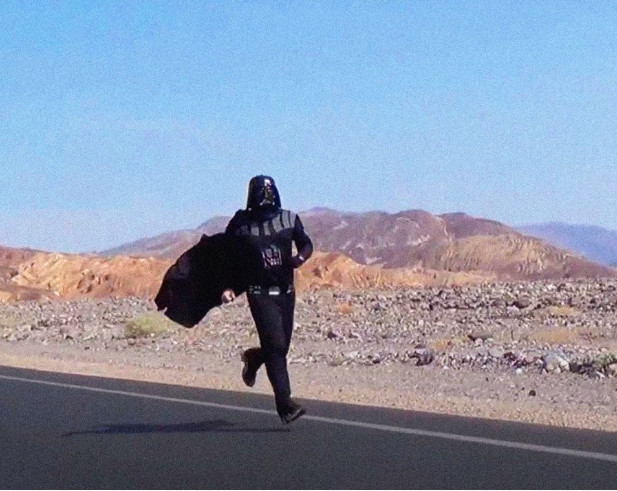
Fastest Walking Mile
Tom Bosworth, 5:31
Of all the feats listed here, this is the only one that doesn’t actually involve running. And yet, it’s also the only one you’re likely to find at a legitimate track meet. Racewalking is very much a sport, despite the fact that it looks like several minutes of that “This one is serious” dash people make for the bathroom after eating bad shellfish. The only rule? Keep one foot in contact with the ground at all times, which distinguishes it from the leaps and bounds of running. Distances usually start at 3,000 meters, and hike all the way up to 100 kilometers (that’s 62 miles), but mile races have some popularity, too. At the 2017 Diamond League in London, British race walker Tom Bosworth clocked in at 5:31, to the delight of a very excited commentator.
Fastest Mile Downhill
Mike Boit, 3:27
We recently covered a virtual, March Madness-style running tournament called “Survival of the Fastest,” in which runners were pitted against each other each week to race a new, specific distance. Downhill racing was allowed in the competition (even encouraged) and by the time the bracket had been whittled down to a final four, every runner involved was hitting start on Strava from the top of a mountain in order to ensure the most competitive time possible. It really does make an absurd difference. Hicham El Guerrouj has holds the official world record for the mile run (3:43), but Mike Boit’s performance in 1983, when he sprinted down a hill through the center of Auckland to a 3:27 finish, is the fastest a human being has ever covered 1,600 meters on his own two feet.
Fastest Mile in Alaska
Ben Blankenship, 3:57
“An Alaskan Mile” was an official selection for the Flagstaff Mountain Film Festival in 2018, and it chronicles an effort by eight elite runners — with Oregon and Olympian pedigrees among them — to become the first to break the four-minute barrier on Alaskan soil. As Trevor Dunbar (one of the runners, the event organizer and from Kodiak, himself) points out, Alaska only has three months where such an accomplishment would be remotely possible, and even then, high winds or even frost could arrive right before the gun goes off. It’s worth the 20-minute watch if you’re interested, but just know that Alaskans were amped to see Minnesotan Ben Blankenship go well under four, setting a new state record.
Fastest Mile on a Treadmill
Anthony Famiglietti, 3:58
It’s Anthony Famigletti’s party, and he’ll run a 3:58 mile on a treadmill if he wants to. A former Olympian who competed in the 3,000-meter steeplechase in Beijing, Famiglietti recruited the fastest American miler ever, Alan Webb (3:46), to help him start breaking four-minute miles into his forties. It worked. This is Famiglietti late last year, on his 41st birthday, running at a 3:58 pace for a full mile on his treadmill. Forget anything you’ve heard about treadmills juicing performance; that’s irrelevant here. Him staying on that machine is akin to deftly canoeing through Class V rapids. And better yet, he got to do it at his own Reckless Running store in Mooresville, North Carolina, which he owns with his wife.
Fastest Mile with a Dog
Anthony Famiglietti, 3:59
More Famigletti. Another impressive sub-four — this one a year earlier, at age 40 — but all credit here goes to Bailey the dog, who casually rolled out of bed to brush against the pinnacle of human athletic achievement, and wanted more. Famigletti affixed Bailey to his waist via a hands-free “bungee” leash (which doesn’t exactly square with our dog running tips, by the way) and ran hard to earn his time. But the fact that Bailey basically dragged an adult 5,280 feet and didn’t once chase a squirrel is the real takeaway here.
Fastest Backwards Mile
Aaron Yoder, 5:54
The Guinness World Record for fastest backpedaled mile ended with the following exchange:
Fastest Chocolate Milk Mile
Mars Bishop, 4:56
On paper, it’s the PG-rated beer mile. But subbing chocolate milk for beer is no joke, and arguably more likely to end in puke penalties. At the 2nd Annual Chocolate Milk Mile in Cranston, Rhode Island, runners slugged cups of the good stuff from East Providence’s Munroe Dairy Farm. A number of runners had to run shame laps for spewing, but runner Mars Bishop torched the track to the tune of 4:56. Because the rules to the Chocolate Milk Mile are exactly the same as the Beer Mile, beermile.com has apparently decided to include the results in its database. (Under beer of choice, they put a chocolate milk logo.) With all respect to Bishop, this record — from 2017 — seems ready to be broken again.
Fastest Mile While Handcuffed
Jeremy Greenwald, 4:52
Save your “running from the cops” jokes, YouTube’s finest have already handled that. Besides, we’re legitimately interested in this from a physical standpoint. Despite the amount of long-distance runners you see without much meat on their arms, the mile is a bang-bang event, where many competitors rely on a dramatic, arm-pumping “kick” in their last lap. To break five with those arms rendered useless is a real challenge. It’s clear from the video that Greenwald, a former Division 1 runner at Georgia Tech, had to rely heavily on his core muscles while keeping his shoulders straight and back; after all, if he fell, the whole thing was over. The previous record for this “event” was 6:37.
Fastest Mile in a Bomb Suit
Daniel Glenn, 8:57
Advanced Bomb Suits weigh 80 pounds, and are reinforced with Kevlar ballistic panels that can withstand blasts traveling at supersonic speeds of over 1,600 m/s. If you’ve seen The Hurt Locker, you have an idea of how serious they are: soldiers routinely get heat exhaustion from just walking around a few paces in one, so for Lt. Daniel Glenn to complete a full mile in one is unheard of. But to do so at the clip of an average American mile time (nine to 10 minutes) is staggering. Even more impressive: he did it in Florida.
Fastest Mile While Juggling
Zach Prescott, 4:43
Yeah, you were probably going to get through your entire life without discovering that “joggling” existed, and you would’ve been just fine. Sorry. Joggling is running while juggling three objects in time, and for decades, Kirk Swenson was the undisputed king of the sport. He joggled a 4:43.8 way back in 1986. Then Boston University runners Zach Prescott came along, and threw three lacrosse balls around en route to a buzzer-beater 4:43.2 victory. Guinness World Records is still in the process of verifying the new record.
Fastest Mile in Death Valley While Wearing a Darth Vader Suit
Jonathan Rice, 6:13
This happened and and there is NOTHING any of us can do about it.
(08/22/2020) Views: 2,116 ⚡AMPJulia Webb runs fastest time ever for a half marathon pushing a stroller
Julia Webb just broke the WORLD RECORD for fastest half marathon while pushing a stroller AND she won the half marathon as well clocking 1:21:23.

Three days ago Julia who is the wife of Alan Webb posted this on Instagram, "I've been a mom of three going on 10 months...I don't think it gets any easier after each kid, it's just your expections of "normal" change and you adapt. I was such a spoiled runner per 2012, treadmills, babysitters, stollers, friends and begging the husband to allow for my escape..."

In the process of setting a new world record she also won the Route 66 Half marathon. When Julia had two kids she unofficiallly broke the Guinness world record pushing baby Paula clocking 1:22:57.
Five days ago on Instagram she wrote, "Time for attempt 2! Fitness great but actual preparation running fast pushing babies lately has been a little sparse. Today's 6:49 mile split in a 5 miler with my beaten down stroller is our fastest yet. New buggy coming Sunday.
"Whatever hapens I will be sure to get this on camera if Alan can keep up."
And she did it this morning... Next up is the US Olympics Trails and this time without the baby.
(11/24/2019) Views: 2,133 ⚡AMP









